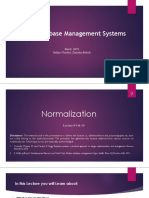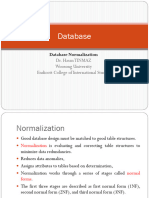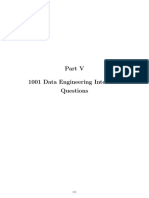0% found this document useful (0 votes)
20 views3 pagesAlgorithms and Normalisation
The document outlines the concept of normalization in database design, emphasizing its purpose to eliminate redundancy, prevent anomalies, and improve data integrity. It details the steps to achieve the first three normal forms (1NF, 2NF, 3NF) and provides algorithms for each, along with practical activities for practicing normalization. The document concludes with a recap of the benefits of normalization and assigns homework to further reinforce the concepts learned.
Uploaded by
monthec39Copyright
© © All Rights Reserved
We take content rights seriously. If you suspect this is your content, claim it here.
Available Formats
Download as DOCX, PDF, TXT or read online on Scribd
0% found this document useful (0 votes)
20 views3 pagesAlgorithms and Normalisation
The document outlines the concept of normalization in database design, emphasizing its purpose to eliminate redundancy, prevent anomalies, and improve data integrity. It details the steps to achieve the first three normal forms (1NF, 2NF, 3NF) and provides algorithms for each, along with practical activities for practicing normalization. The document concludes with a recap of the benefits of normalization and assigns homework to further reinforce the concepts learned.
Uploaded by
monthec39Copyright
© © All Rights Reserved
We take content rights seriously. If you suspect this is your content, claim it here.
Available Formats
Download as DOCX, PDF, TXT or read online on Scribd
/ 3























































































